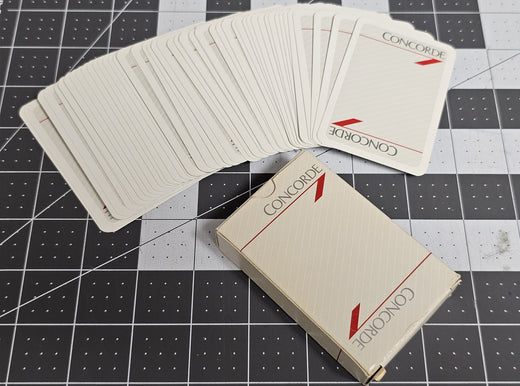This Fine Art Print by Artist Craig Tinder depicts the only supersonic passenger airliner - the Concorde as she pulls through the clouds on her transatlantic crossing. This Limited Edition Canvas Print includes an actual Concorde playing card that passengers were given in their gift packs during their transatlantic crossings.
Details About the RELIC:
This playing card, produced by Carta Mundi in Belgium, dates back to 1987 and was aboard the iconic Concorde during transatlantic flights. The card features the aircraft’s Landor Livery, a design used between 1985 and 1997, which became synonymous with the sleek, luxurious look of the Concorde fleet during this era. As part of the exclusive gift set given to passengers, these cards offered a unique keepsake from a one-of-a-kind flight experience.
 Deck of cards that were aboard the Concorde in 1987 and are included with "The Time Machine" limited edition prints
Deck of cards that were aboard the Concorde in 1987 and are included with "The Time Machine" limited edition prints
The gift set typically included a velvet carrying pouch, an aircraft fact sheet with Concorde specifications and history, and a menu showcasing the in-flight gourmet dining options. Concorde, known for its supersonic speed and ability to cross the Atlantic in under three hours, provided passengers not just with unmatched travel but also with rare and collectible memorabilia.
 Artist, Craig Tinder, with "The Time Machine" limited edition relic canvas
Artist, Craig Tinder, with "The Time Machine" limited edition relic canvas
The gift set typically included a velvet carrying pouch, an aircraft fact sheet with Concorde specifications and history, and a menu showcasing the in-flight gourmet dining options. Concorde, known for its supersonic speed and ability to cross the Atlantic in under three hours, provided passengers not just with unmatched travel but also with rare and collectible memorabilia.
 Double sleeved playing card attached to each canvas
Double sleeved playing card attached to each canvas
Each canvas art print in this collection includes a single playing card from the original deck, preserved in a double-sleeved protective case, offering a tangible connection to one of the most famous aircraft in aviation history.
The Story Behind the Print:
The Concorde, one of the most iconic aircraft in aviation history, made nearly 50,000 flights and carried over 2.5 million passengers at speeds more than twice the speed of sound. This remarkable aircraft reduced flight times between New York and London to under 3.5 hours, setting records such as flying from New York to London in under 3 hours. Its advanced jet engines featured 're-heat' technology, providing the additional thrust needed for takeoff and maintaining supersonic speeds.
One of the Concorde's unique characteristics was its ability to stretch by up to 10 inches during flight due to the immense heat generated at supersonic speeds. Its distinctive design and performance led it to be regarded as the most tested aircraft in history. Nicknamed the 'Time Machine,' the Concorde's supersonic capabilities meant that it could take off and, due to time zone differences, land at its destination before its recorded departure time.
After nearly 30 years of service, the last Concorde flight took place in 2003, marking the end of the world’s only supersonic passenger service. Following its retirement, the aircraft were sent to various museums and display sites around the world, where they remain as a testament to one of the greatest achievements in aviation engineering.
Learn more about The Supersonic Marvel of Aviation History of Concorde, Click Here
To purchase or see similar items, visit here.
Commissioned by Museums, Treasured by Collectors





Share:
Silent Watch, the story behind "Tomahawk Patrol"
Legacy of Courage, the story behind "Pathfinder to Ploesti"